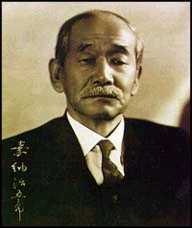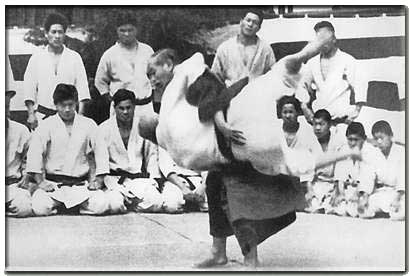

Reasons For The Deterioration Of Practice
There are two reasons why recent practice has deteriorated. One of the reasons is the fact that we encouraged practitioners to participate in matches such as tsukinami (monthly matches) and kohaku (red and white) matches in order to stimulate the spread of Judo. In order to hold matches it was necessary to make specific rules by which we could judge them. Shihan (senior instructors) are not always available as judges. Even when I myself attended and acted as a judge it was necessary for me to follow the set and simple rules. Otherwise, it would not be clear to the others who had won or lost. In addition, when those other than shihan had to act as judges it was necessary that they follow rules which were uncomplicated and clear. Once it was decided to judge matches according to specific rules, some problems naturally arose because people became too concerned with the rules, and this prevented them from achieving my ideal of natural movement.
The second reason for this deterioration has been the shortage of qualified instructors who can teach randori properly due to the rapid increase in the number of Judo practitioners. Because of this shortage, my original method of randori was not sufficiently followed. The practitioners no longer had the opportunity to learn it properly, and in many cases they just wrestled with each other, and matched force with force. We now see many people practicing randori in a way contrary to the original method.

How To Correct Bad Influences
Because of the prevalence of this false method of randori, we must try to find a way to rescue the future of Judo from this bad influence. In order to succeed, we should first of all identify the points to look for whether we consider Judo as physical education or as martial art. When we study Judo as a physical exercise the best posture is naturally not one with our necks stuck forward, or with our bodies bent or stiff. We should stand in a natural and relaxed way, and be able to direct our energy freely and instantly into our necks, arms, legs and hips when necessary, so that we can immediately react as we will with harmonious movements. When we study Judo as a martial art, we should be able to move our bodies freely, lightly and swiftly so that we can dodge whenever our opponent attacks us with a kick or a jab. At the Kodokan, we grab our opponents by their sleeves or lapels when we practice randori. This method is, however, only necessary to help beginners, so as we become advanced we do not necessarily do it. Even when we grab our opponent we should do it lightly, otherwise we are not able to dodge swiftly.
If you practice Judo following these points, you can avoid bad tendencies that are seen today such as using unnecessary strength or tackling each other. Our posture should be similar to that of boxers, rather than that of wrestlers. Wrestlers assume a forward stance because they do not have to be prepared for punches. However, if we are expecting atemi (punch) we must take a posture similar to a boxer's. In Judo, we do not necessarily keep distance between ourselves and our opponent like in boxing because we not only punch, but can also throw or execute a counter. We approach our opponent and try to grab him by his clothing, hand or neck. In these cases, we must be prepared for him to punch or kick. So how should we approach our opponent? When we pull him by his right wrist or sleeve, we should move to his right side. By doing this, we can avoid any counterattack, because his right arm is not free. Although his left hand is free, it is not so dangerous because it is far enough away. His left leg is not in a convenient position from which to attack either, while his right leg is too close to attack properly. We have to keep this in mind when approaching an opponent. We cannot move close to him. What is, then, the most efficient way to practice randori? We have come to the conclusion that we must return to the way it was done in the beginning of the Kodokan.